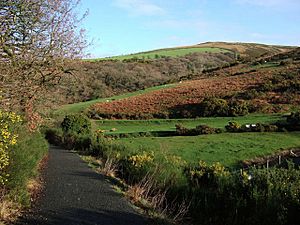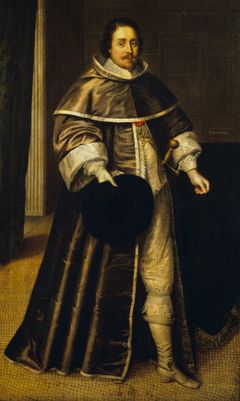Battle of Sourton Down facts for kids
Quick facts for kids Battle of Sourton Down |
|||||||
|---|---|---|---|---|---|---|---|
| Part of the First English Civil War | |||||||
 Sourton Down; the hedges and landscape helped the Parliamentarian ambush |
|||||||
|
|||||||
| Belligerents | |||||||
| Commanders and leaders | |||||||
| Sir Ralph Hopton Lord Mohun Sir Bevil Grenville Sir Nicholas Slanning |
James Chudleigh | ||||||
| Strength | |||||||
| c. 3,000 infantry 300 cavalry 300 dragoons 4 guns |
c. 108 cavalry 1,000 infantry |
||||||
| Casualties and losses | |||||||
| 60 dead | Minimal | ||||||
The Battle of Sourton Down was a clever surprise attack by the Parliamentarian army. It happened at Sourton Down in South West England on April 25, 1643. This battle was part of the First English Civil War.
The Parliamentarians had tried to attack Royalist-held Launceston but failed. They had to retreat to their base in Okehampton. A Royalist army, led by Sir Ralph Hopton, chased them. Hopton planned a surprise attack on Okehampton at dawn.
When the Parliamentarian leader, Major-General James Chudleigh, found out, he had a problem. His army was smaller than Hopton's. But he did not want to leave his cannons for the enemy. So, he decided to fight back. He planned a surprise attack of his own.
Chudleigh ambushed Hopton's 3,600 Royalist soldiers on Sourton Down. He used only 108 of his own cavalry (soldiers on horseback). The ambush completely surprised the Royalist army. Many of their soldiers ran away immediately.
Chudleigh asked for more soldiers from his infantry (foot soldiers) in Okehampton. But the Royalists saw them coming. The Royalist cannons fired, and the Parliamentarian infantry scattered. Chudleigh's smaller force decided to retreat. The Royalists were very confused and also pulled back. They did not know how small the attacking force had been.
This defeat was embarrassing for Hopton. The Parliamentarians captured many weapons and supplies. They also found letters from King Charles. These letters told Hopton to meet another Royalist army. This discovery made the Parliamentarian commander, the Earl of Stamford, too confident. Three weeks later, at the Battle of Stratton, Hopton won a big victory. This battle helped the Royalists control the West Country. Chudleigh was captured there and later switched sides.
Contents
Why the Battle Happened
When the First English Civil War started in August 1642, England was divided. In the West Country, Cornwall mostly supported the King (Royalists). Devon and Somerset mostly supported Parliament (Parliamentarians). But there were people on both sides in all areas.
In July, King Charles made the Marquess of Hertford the commander in the west. Sir Ralph Hopton was his second-in-command. They set up their base in Wells. But a larger Parliamentarian army forced them to retreat. Hopton then joined other Royalists in Cornwall. Their army was mostly made of local soldiers. These soldiers did not want to fight outside Cornwall. So, important local leaders like Sir Bevil Grenville and Sir Nicholas Slanning played big roles.
Parliament also gathered soldiers in Devon. James Chudleigh was a local landowner's son. He was allowed to raise 1,000 soldiers. These soldiers helped protect Barnstaple in north Devon. In January 1643, the Earl of Stamford became the main Parliamentarian commander in the West Country. He made Chudleigh his deputy.
Leading Up to the Fight

A Royalist victory at the Battle of Braddock Down in January 1643 gave Hopton control of Cornwall. He wanted to attack Plymouth. But Plymouth was easy to resupply by sea. Also, the Cornish soldiers refused to cross into Devon. After some small fights, both sides agreed to a local truce. This truce allowed Hopton to go back to Cornwall. Many Parliamentarians thought this truce mostly helped the Royalists.
The truce was set to end on April 22. Chudleigh gathered about 1,600 soldiers near Launceston. Hopton had gathered his army there too. Chudleigh attacked around 10:00 am the next morning. He surprised the Royalists. But they quickly fought back. Chudleigh's smaller force had to go back to their base at Okehampton. Hopton did not chase them. He noted that his Cornish soldiers often became "disorderly" after a battle.
When Chudleigh reached Okehampton, some of his units left. He was left with 1,000 foot soldiers and a few troops of dragoons. The Royalists thought this meant Chudleigh was fully retreating. Hopton decided to take advantage. He left Launceston with 3,000 foot soldiers, 300 cavalry, and 300 dragoons. They planned to stop for the night at Sourton Down. Then they would attack Okehampton at dawn.
By chance, a Parliamentarian scout saw them. He told Chudleigh around 9:00 pm that the enemy was only 2 miles away. Chudleigh was upset that his scouts had not warned him sooner. Also, his cannons had been moved to Crediton against his orders. He did not want to lose the cannons he had saved at Launceston. So, Chudleigh decided to launch a counterattack.
The Battle of Sourton Down
Chudleigh left his 1,000 foot soldiers to follow him. He took his 108 cavalry soldiers to Sourton Down. He found a valley with hills around it. This allowed his men to hide without being seen against the sky. He split his cavalry into six groups of eighteen men. They spread out and waited. The Royalists did not know they were there. Hopton later said he and his officers were "carelessly entertaining themselves" at the front of their column. The ambush began around 11:00 pm.
Chudleigh told his men to make as much noise as possible. He wanted to make the Royalists think they were facing a much larger army. Captain Thomas Drake led the first attack. His group charged out of the darkness, shouting and firing their weapons. The Royalist dragoons were mostly new soldiers. They broke and ran, pushing back the cavalry behind them. Hopton himself was caught in the panic.
A strong thunderstorm started at the same time. The noise and lightning panicked the Cornish foot soldiers. Many threw away their weapons and ran. Chudleigh's cavalry at first took over the Royalist cannons. But Sir Slanning managed to get the cannons back. He set up a defense among old earthworks on the moor. He used sharpened wooden stakes to help protect them.
Chudleigh used his cavalry to stop the Royalists from getting organized again. He waited for his foot soldiers to arrive from Okehampton. He planned to attack Slanning's position. As the foot soldiers came closer, the Royalist cannons saw their lit matches. They opened fire, scattering the Parliamentarian foot soldiers. Chudleigh was still outnumbered. He had achieved his main goal of surprising the enemy. So, he ordered his men to hang lit matches in gorse bushes. This made it look like they were still there. Then, they quietly pulled back.
The Royalists were unsure how big the attacking force was. They stayed in their defensive position until morning. Then they retreated. First, they went to Bridestowe, a village about 2 miles away. Later that day, they went all the way back to Launceston.
What Happened Next
Do you not know, not a fortnight agoe,
How they brag'd of a Western wonder?
When a hundred and ten, slew five thousand men,
With the help of Lightning and Thunder.There Hopton was slain, again and again,
— Sir John Denham, A Western Wonder
Or else my Author did lye;
With a new Thanksgiving, for who are living,
To God, and his Servant Chudleigh.
The Royalists left behind many weapons, gunpowder, and supplies. They even left Hopton's personal bags. These bags held letters from King Charles. The letters ordered Hopton's Cornish army to join other Royalist forces. Even though it was a defeat, the Royalists did not lose many men. Around 20 to 100 soldiers were killed. About a dozen were captured. One captured soldier, 15-year-old Captain Christopher Wrey, escaped. He brought some other scattered soldiers with him.
Even though he was not there, the Earl of Stamford got credit for the victory. This was good news for Parliament in the west. Reports published in London were often made up. They were used to spread news that helped their side. One report even said Hopton died after being shot. In response, a Royalist poet, Sir John Denham, wrote a poem. It was called A Western Wonder. It made fun of these false reports. It also praised the Royalist victory that happened later at Stratton.
Finding Hopton's secret orders made Stamford very happy. He thought it was a chance for a big victory. He gathered the largest army he could. He took soldiers from other towns and brought in more from Somerset. He believed this would be the "deciding contest" for the war in the West. However, in May, Hopton defeated him at the Battle of Stratton. This victory secured Royalist control of Cornwall and Devon. It also led to Stamford surrendering Exeter in September. Hopton then moved into Somerset. Parliament had to send another army to stop him.


